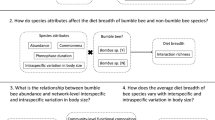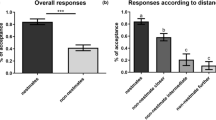Abstract
The bark beetle Dendroctonus rhizophagus is endemic to northwestern Mexico where it kills immature pines < 3 m tall. We report the first investigation of the chemical ecology of this pest of forest regeneration. We used GC-EAD to assess olfactory sensitivity of this species to volatile compounds from: resin of a major host, Pinus arizonica; mid/hindguts of single, gallery-initiating females; and mate-paired males within galleries of attacked host trees in the field. Antennae of both sexes responded to monoterpenes α-pinene, β-pinene and 3-carene as well as to the beetle-derived oxygenated monoterpenes fenchyl alcohol, myrtenal, cis-verbenol, trans-verbenol, verbenone, and myrtenol. These monoterpenes were quantified from pre-emerged D. rhizophagus adults forced to attack host tissue in the laboratory, and from individuals dissected from naturally-attacked hosts at different stages of colonization. In both bioassays, myrtenol and trans-verbenol were the most abundant volatiles, and trans-verbenol was the only one produced in significantly greater quantities by females than males in a naturally-colonized host. Two field experiments were performed to evaluate behavioral responses of D. rhizophagus to antennally-active monoterpenes. Results show that 3-carene was significantly attractive either alone or in a ternary (1:1:1) combination with α-pinene and β-pinene, whereas neither α-pinene nor β-pinene alone were attractive. None of the beetle-associated oxygenated monoterpenes enhanced the attractiveness of the ternary mixture of monoterpenes, while verbenone either alone or combined with the other five oxygenated terpenes reduced D. rhizophagus attraction to the ternary mixture. The results suggest that attraction of D. rhizophagus to the host tree P. arizonica is mediated especially by 3-carene. There was no conclusive evidence for an aggregation or sex attractant pheromone.






Similar content being viewed by others
References
Bentz, B. J., Régnière, J., Fetting, C. J., Hansen, M., Hayes, J. L., Hicke, J. A., Kelsey, R. G., Negrón, J. F., and Seybold, S. J. 2010. Climate change and bark beetle of the Western United States and Canada: Direct and indirect effects. BioScience. 60:602–613.
Birgersson, G. and Bergstrom, G. 1989. Volatiles released from individual spruce bark beetle entrance holes - Quantitative variations during the first week of attack. J. Chem. Ecol. 15:2465–2483.
BLOMQUIST, G. J., FIGUEROA-TERAN, R., AW, M., SONG, M. M., GORZALSKI, A., ABBOTT, N. L., CHANG, E., and TITTIGER, C. 2010. Pheromone production in bark beetles. Insect Biochem. Mol 40:699–712.
Borden, J. H. 1982. Aggregation pheromones, pp. 74–139, in J. B. Mitton and K. B. Sturgeon (eds.), Bark Beetles in North American Conifers: A System for the Study of Evolutionary Biology. University of Texas Press, Austin.
Borden, J. H. 1996. Disruption of semiochemical-mediated aggregation in bark beetles, pp. 421–438, in R. T. Cardé and A. K. Minks (eds.), Pheromone Research: New Directions. Chapman and Hall, New York.
Byers, J. A., Lanne, B. S., and Lofqvist, J. 1989. Host tree unsuitability recognized by pine shoot beetles in flight. Experientia 45:489–492.
Byers, J. A. 1995. Host tree chemistry affecting colonization in bark beetles, pp. 154–213, in R. T. Cardé and W. J. Bell (eds.), Chemical Ecology of Insects 2. Chapman and Hall, New York.
Cibrián-Tovar, D., Méndez Montiel, J. T., Campos Bolaños, R., Yates III, H. O., and FLORES LARA, J. 1995. Insectos Forestales de México/Forests Insects of México COFAN/NAFC. Universidad Autónoma Chapingo, México.
Conn, J. E., Borden, J. H., Scott, B. E., Frieske, L. M., Pierce, H. D., and Oehlschlager, A. C. 1983. Semiochemicals for the mountain pine beetle, Dendroctonus ponderosae (Coleoptera: Scolytidae) in British Columbia: field trapping studies. Can. J. For. Res. 13:320–324.
Dodds, K. J. and Miller, D. R. 2010. Test of nonhost angiosperm volatiles and verbenone to protect trap trees for Sirex noctilio (Hymenoptera: Siricidae) from attacks by bark beetles (Coleoptera: Scolytidae) in the Northeastern United States. J. Econ. Entomol. 103:2094–2099.
ESTRADA-MURRIETA, O. 1983. Biología del descortezador del renuevo de pino Dendroctonus rhizophagus Thomas y Bright (Col.: Scolytidae) en la región Mesa del Huracán, Chih. Bachelor thesis. Universidad Autónoma de Chapingo, México.
Erbilgin, N., Mori, S. R., Sun, J. H., Stein, J. D., Owen, D. R., Merrill, L. D., Campos Bolaños, R., Raffa, K. F., Méndez Montiel, T., Wood, D. L., and Gillette, N. E. 2007. Response to host volatiles by native and introduced populations of Dendroctonus valens (Coleoptera: Curculionidae, Scolytinae) in North America and China. J. Chem. Ecol. 33:131–146.
Gillette, N. E., Stein, J. D., Owen, D. R., Webster, J. N., Fiddler, G. O., Mori, S. R., and Wood, D. L. 2006. Verbenone-releasing flakes protect individual Pinus contorta trees from attack by Dendroctonus ponderosae and Dendroctonus valens (Coleoptera: Curculionidae, Scolytinae). Agr. For. Entomol. 8:243–251.
Hobson, K. R., Wood, D. L., Cool, L. G., White, P. R., Ohtsuka, T., KUBO, I., and ZAVARIN, E. 1993. Chiral specificity in responses by the bark beetle Dendroctonus valens to host Kairomones. J. Chem. Ecol. 19:1837–1846.
Hughes, P. R. 1973. Dendroctonus: production of pheromones and related compounds in response to host monoterpenes. Z. Angew. Entomol. 73:294–312.
Hughes, P. R. 1975. Pheromones of Dendroctonus: origin of α-pinene oxidation products present in emergent adults. J. Insect Physiol. 21:687–691.
Hunt, D. W. A., Borden, J. H., Lindgren, B. S., and Gries, G. 1989. The role of autoxidation of α-pinene in the production of pheromones of Dendroctonus ponderosae (Coleoptera: Scolytidae). Can. J. For. Res. 19:1275–1282.
Hunt, D. W. A. and Borden, J. H. 1990. Conversion of verbenols to verbenone by yeasts isolated from Dendroctonus ponderosae (Coleoptera: Scolytidae). J. Chem. Ecol. 16:1385–1397.
Leufven, A. and Birgersson, G. 1987. Quantitative variation of different monoterpenes around galleries of Ips typographus (Coleoptera, Scolytidae) attacking Norway spruce. Can. J. Bot. 65:1038–1044.
Lindgren, B. S. 1983. A multiple funnel trap for scolytid beetles. Can. Entomol. 115:299–302.
Lindgren, B. S., Nordlander, G., and Birgersson, G. 1996. Feeding deterrence of verbenone to the pine weevil, Hylobius abietis (L) (Col, Curculionidae). J. Appl. Entomol. 120:397–403.
Lindgren, B. S. and Miller, D. R. 2002a. Effect of verbenone on attraction of predatory and woodboring beetles (Coleoptera) to kairomones in lodgepole pine forests. Environ. Entomol. 31:766–773.
Lindgren, B. S. and Miller, D. R. 2002b. Effect of verbenone on five species of bark beetles (Coleoptera: Scolytidae) in lodgepole pine forests. Environ. Entomol. 31:759–765.
López, M. F., Cano-Ramírez, C., Shibayama, M., and Zúñiga, G. 2011. α-Pinene and myrcene induce ultrastructural changes in the midgut of Dendroctonus valens (Coleoptera: Curculionidae: Scolytinae). Ann. Entomol. Soc. Am. 104:553–561.
Lyon, R. L. 1958. Useful secondary sex character in Dendroctonus Bark Beetles. Can. Entomol. 90:552–558.
Mendoza, M. G., Salinas-Moreno, Y., Olivo-Martínez, A., and Zúñiga, G. 2011. Factors influencing the geographical distribution of Dendroctonus rhizophagus (Coleoptera: Curculionidae: Scolytinae) in the Sierra Madre Occidental. México. Environ. Entomol 40:549–559.
Miller, D. R. and Borden, J. H. 2000. Dose-dependent and species-specific responses of pine bark beetles (Coleoptera: Scolytidae) to monoterpenes in association with pheromones. Can. Entomol. 132:183–195.
Phillips, T. W., Nation, J. L., Wilkinson, R. C., and Foltz, J. L. 1989. Secondary attraction and field activity of beetle-produced volatiles in Dendroctonus terebrans. J. Chem. Ecol. 5:1513–1533.
Pierce, H. D., Conn, J. E., OEHLSCHLAGER, A. C., and BORDEN, J. H. 1987. Monoterpene metabolism in female mountain pine beetles, Dendroctonus ponderosae Hopkins, attacking ponderosa pine. J. Chem. Ecol. 13:1455–1480.
Raffa, K. F., Phillips, T. W., and Salom, S. M. 1993. Strategies and mechanisms of host colonization by bark beetles, pp. 103–128, in R. D. Schowalter and G. M. Filip (eds.), Beetle-Pathogen Interactions in Conifer forests. Academic, London.
Rappaport, N. G., Owen, D. R., and Stein, J. D. 2001. Interruption of semiochemical-mediated attraction of Dendroctonus valens (Coleoptera: Scolytidae) and selected nontarget insects by verbenone. Environ. Entomol. 30:837–841.
Renwick, J. A. A., Hughes, P. R., and Ty, T. D. 1973. Oxidation products of pinene in the bark beetle Dendroctonus frontalis. J. Insect Physiol. 19:1735–1740.
Salinas-Moreno, Y., Mendoza, M. G., Barrios, M. A., Cisneros, R., Macías-Sámano, J., and Zúñiga, G. 2004. Areography of the genus Dendroctonus (Coleoptera: Curculionidae: Scolytinae) in Mexico. J. Biogeogr. 31:1163–1177.
Salinas-Moreno, Y., Ager, A., Vargas, C. F., Hayes, J. L., and Zúñiga, G. 2010. Determining the vulnerability of Mexican pine forests to bark beetles on the genus Dendroctonus Erichson (Coleoptera: Curculionidae: Scolytinae). Forest Ecol. Manag. 260:52–61.
Sánchez-Martínez, G. and Wagner, M. R. 2009. Host preference and attack pattern of Dendroctonus rhizophagus (Coleoptera: Curculionidae: Scolytinae): A bark beetle specialist on pine regeneration. Environ. Entomol. 38:1197–1204.
SAS INSTITUTE. 1989. SAS Users Guide. Release 6.09 edition. SAS. Institute, Cary, North Carolina.
SEMARNAT. 2005. Aprovechamiento de los recursos forestales, pesqueros y de la vida silvestre. México. http://app1.semarnat.gob.mx/dgeia/informe_resumen/pdf/5_info_resumen.pdf.
Seybold, S. J., Huber, D. P. W., Lee, J. C., Graves, A. D., and Bohlmann, J. 2006. Pine monoterpenes and pine bark beetles: A marriage of convenience for defense and chemical communication. Phytochem. Rev. 5:143–178.
Shi, Z. H. and Sun, J. H. 2010. Quantitative variation and biosynthesis of hindgut volatiles associated with the red turpentine beetle, Dendroctonus valens LeConte, at different attack phases. Bull. Entomol. Res. 100:273–277.
SKILLEN, E. L., BERISFORD, C. W., CAMAAN, M. A., and REARDON, R. C. 1997. Semiochemicals of Forest and Shade Tree Insects in North America and Management Applications. USDA Forest Service Forest Health Technology Enterprise Team Publication FHTET-96-15. 182 p.
Slone, D. H. and SULLIVAN, B. T. 2007. An automated approach to detecting signals in electroantennogram data. J. Chem. Ecol. 33:748–1762.
SMITH, R. H. 2000. Xylem monoterpenes of pines: Distribution, variation, genetics, function. Gen. Tech. Rep. PSW-GTR-177. Albany, CA: Pacific Southwest Research Station, Forest Service, U.S. Department of Agriculture.
Sullivan, B. T. 2005. Electrophysiological and behavioral responses of Dendroctonus frontalis (Coleoptera: Curculionidae) to volatiles isolated from conspecifics. J. Econ. Entomol. 98:2067–2078.
Sun, J., Miao, Z. W., Zhang, Z., Zhang, Z. N., and Gillette, N. E. 2004. Red turpentine beetle, Dendroctonus valens LeConte (Coleoptera: Scolytidae), response to host semiochemicals in China. Environ. Entomol. 33:206–212.
Sun, J. H., Zhang, L. W., and Clarke, S. R. 2006. Effects of verbenone dose and enantiomer on the interruption of response of the red turpentine beetle, Dendroctonus valens LeConte (Coleoptera: Scolytidae), to its kariomones. Environ. Entomol. 35:655–660.
Tittiger, C., Keeling, C. I., and Blomquist, G. J. 2005. Some insights into the remarkable metabolism of the bark beetle midgut. Recent Adv. Phytochem. 39:57–78.
Wood, D. L. 1982. The role of pheromones, kairomones, and allomones in the host selection and colonization behaviour of bark beetles. Annu. Rev. Entomol. 27:411–446.
Wood, S. L. 1982. The bark and ambrosia beetles of North and Central America (Coleoptera: Scolytidae), a taxonomic monograph. Great Basin Nat. Mem. 6:1–1359.
Zhang, L. and Sun, J. 2006. Electrophysiological and behavioral responses of Dendroctonus valens (Coleoptera: Curculionidae: Scolytinae) to candidate pheromone components identified in hindgut extracts. Environ. Entomol. 35:1232–1237.
Acknowledgments
We are grateful to Karina Martínez, Héctor García, Adrian Sotelo, Fernanda López, Veronica Pineda, Karina Cesar, Jesús Morales, Alicia Niño, Daniel Antonio, Marco Espinal, and Ramón Cisneros for assistance in collecting insects, and to Lic. Jaime Chávez and COPAMEX for providing us access to installations and for logistic support in San Juanito Chihuahua. The project was funded by Comisión Nacional Forestal-Consejo Nacional de Ciencia y Tecnología (CONAFOR-CONACYT 69539) and Secretaría de Investigación y Posgrado-IPN (SIP-20090576). This work was part of CCR’s Ph.D. dissertation. She was a Consejo Nacional de Ciencia y Tecnología (202060) and Programa Institucional de Formación de Investigadores del Instituto Politécnico Nacional (PIFI-IPN) fellowship. B.T.S. was supported by the Southern Research Station and J.E.M.S by Synergy Semiochemical Corporation Inc.
Author information
Authors and Affiliations
Corresponding author
Electronic supplementary material
Below is the link to the electronic supplementary material.
Fig. S1
Linear response for each compound: (a) fenchyl alcohol, (b) cis-verbenol, (c) myrtenal, (d) trans-verbenol, (e) myrtenol, and (f) verbenone; used in the response curves for the quantification of compounds (JPEG 490 kb).
Fig. S2
Mass spectra of each compounds analyzed: (a) myrtenol, (b) trans-verbenol, (c) myrtenal, (d) cis-verbenol, (e) verbenone, and (f) cycloheptanone as internal standard showing the absence of co-eluting compounds. (PDF 718 kb)
Rights and permissions
About this article
Cite this article
Cano-Ramírez, C., Armendáriz-Toledano, F., Macías-Sámano, J.E. et al. Electrophysiological and Behavioral Responses of the Bark Beetle Dendroctonus rhizophagus to Volatiles from Host Pines and Conspecifics. J Chem Ecol 38, 512–524 (2012). https://doi.org/10.1007/s10886-012-0112-z
Received:
Revised:
Accepted:
Published:
Issue Date:
DOI: https://doi.org/10.1007/s10886-012-0112-z




